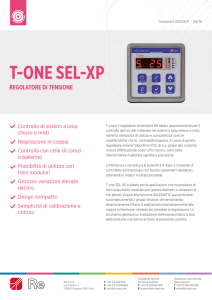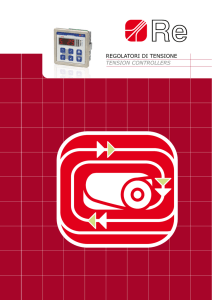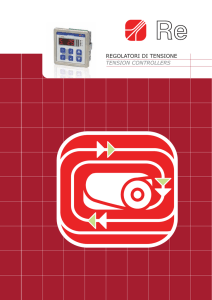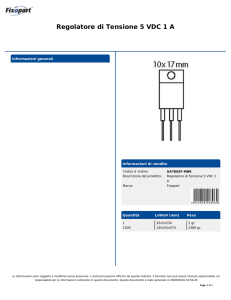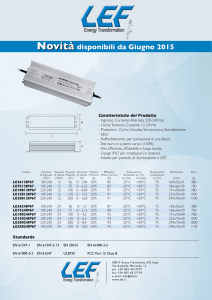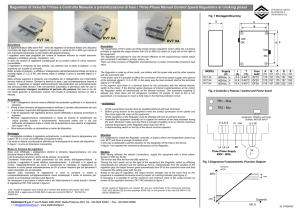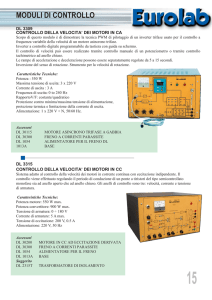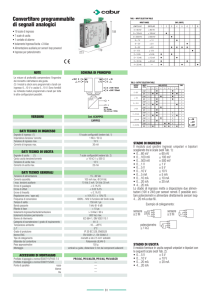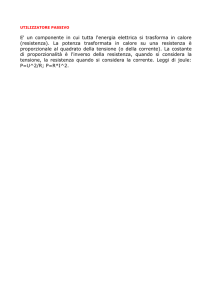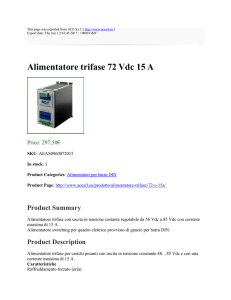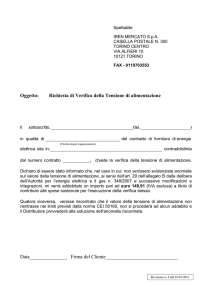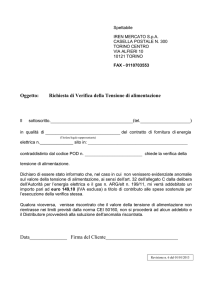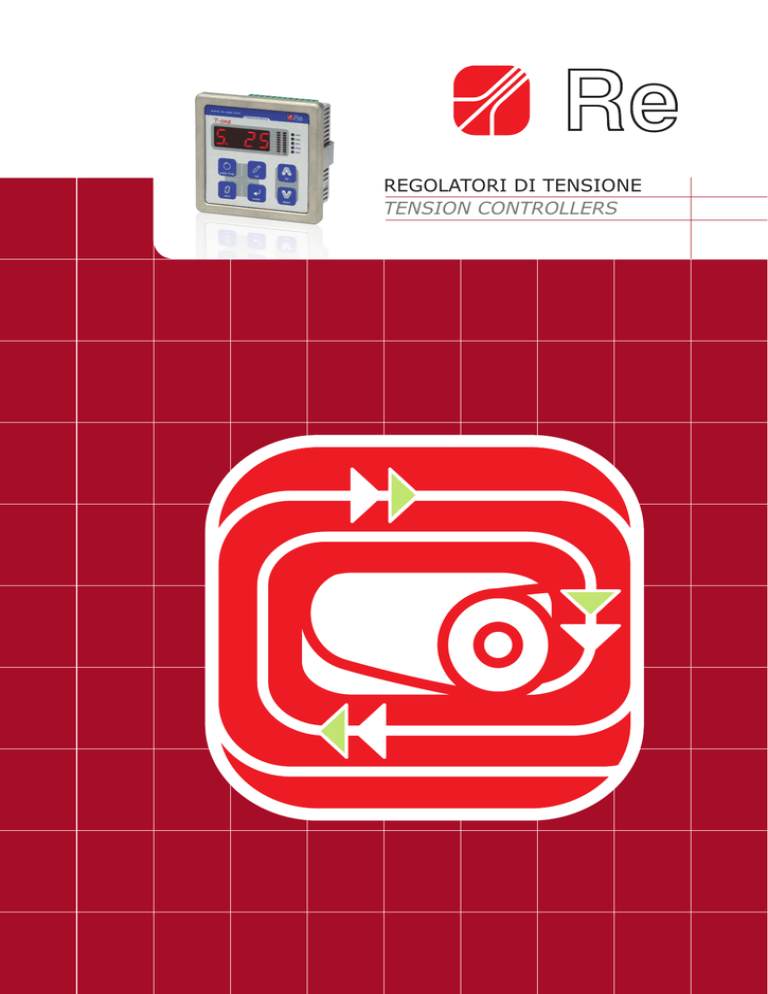
REGOLATORI DI TENSIONE
TENSION CONTROLLERS
1
m a d e
2
i n
I t a l y
Da più di 40 anni sviluppiamo e produciamo controlli di tensione per
i laminati e non solo. Sono migliaia le applicazioni nel settore del
converting, della carta e cartone, alluminio, filo e tessuto che hanno
visto applicato i nostri sistemi, dai primi controlli analogici in rack
70.01, alla serie MW.90 che ha visto oltre 5000 unità installate in
tutto il mondo e oltre 100 software dedicati e sviluppati ad hoc
per decine di clienti, fino alla serie T-One e all'ultimo nato T-Two
che già contano migliaia di pezzi e una serie di soluzioni integrate
alle esigenze più diverse dei nostri clienti.
La caratteristica principale dei nostri sistemi che ci ha contraddistinto
negli anni e nei diversi continenti sono la semplicità d’uso, la
compattezza e la flessibilità del software.
Realizziamo controlli di tensione a loop aperto, usando sensori di
rilevamento del diametro o di posizione e sistemi a loop chiuso,
usando celle di carico e ballerini laddove previsto.
Nel caso degli svolgitori il controllo di tensione può essere
completato con i freni pneumatici o elettromagnetici a polvere che
compongono la nostra vasta gamma di produzione.
REGOLATORI DI TENSIONE
TENSION CONTROLLERS
Since 40 years we develop and produce tension controllers for
laminating and more. Are thousands the applications in the
converting industry, paper and paperboard, aluminum foil, textile,
wire and cables with our systems, from the beginning with the
analogical control 70.01, later with the series MW.90, with more
than 5000 systems installed everywhere in the world and more
than 100 customized software for our customers, till the T-One
series and the new one T-two, already well introduced in the
market with integrated solutions for many different applications.
The main feature of our system is the simplicity, the compactness
and the software’s flexibility.
We realize tension controllers with open loop, using ultrasonic
sensor reading the roll diameter and closed loop, using load cells
and dancing roller wherever necessary.
On the unwind roll stand the tension controllers are accomplished
with our pneumatic and electromagnetic brakes available in our
range of products.
3
T-ONE
T-One è il regolatore di tensione Re che aggiunge alle
caratteristiche che hanno permesso al nostro storico
regolatore MW 90.10 di affermarsi in tutto il mondo, una
semplicità di utilizzo e una compattezza nelle dimensioni
senza eguali.
T-One è stato ideato appositamente per il controllo del tiro
del materiale nei sistemi a loop chiuso.
Il cuore di questo controllo di tiro rimane il P.I.D. che, grazie
alle continue ricerche effettuate dai nostri uffici tecnici, è
stato migliorato e reso più rapido e preciso rispetto ai suoi
predecessori. Un’interfaccia semplice a 6 pulsanti e 4 digit,
consente con facilità di controllare ed impostare i parametri
desiderati in modo da ottenere i migliori risultati.
T-One consente di effettuare la regolazione del tensionamento
dei laminati tramite l’utilizzo di celle di carico o ballerino sia
in fase di avvolgimento e svolgimento del materiale, sia
in fase di processazione. A seconda dei sitemi in cui viene
utilizzato e delle funzioni necessarie da svolgere, esistono
diversi modelli di T-One.
109
T-One is Re tension control which adds new characteristics
such as the compact dimensions and the easiness to use, to
the basic functions that have allowed our MW.90.10 to be
distributed worldwide.
T-One has been appropriately designed for the web tension
control in closed-loop systems.
The core of T-One is the P.I.D. algorithm, that, thanks to
the continuous researches made by our technicians, has
been improved and made faster. An easy structure interface
with 6 buttons and 4 digits, allows to control and set up
the desired parameters to obtain the best results. T-One
allows the tension regulation using the load cells or the
dancing roller both in unwinding, rewinding and processing.
Depending on the system, we can provide different types of
T-One.
40
109
10
67
Caratteristiche tecniche / Technical characteristics
Alimentazione / Supply
24 Vdc
Potenza / Power
8 W max
Ingresso analogico per celle di carico /
Analog input for load cells
0÷20 mV / 4÷20 mA
Ingresso analogico / Analog inputs
0÷10 V per set point remoto (regolazione in coppia)
o per velocità di linea (regolazione in velocità)
0÷10 V for remote setpoint (regulation in torque)
or for line speed (regulation in speed)
Ingressi digitali / Digital inputs
2 ingressi a 24 V per comandi remoti (auto/stop, emergenza)
2 inputs 24V for remote controls (auto/stop, emergency)
Uscita analogica PID /
PID analog output
0÷10 V / 4÷20 mA
Uscita analogica / Analog output
0÷10 V per la visualizzazione del tiro o del comando pistone ballerino
0÷10V for the visualization of the tension or the dancer roller piston
control
Uscite digitali / Digital outputs
2 uscite a relè 24 Vdc / 24 Vac per allarmi
2 relay outputs 24 Vdc / 24 Vac for alarms
Peso / Weight
400 g
Temperatura di lavoro / Operating temperature
0÷50 °C
Grado di protezione / Protection class
IP20 (custodia), IP52 (pannello frontale)
IP20 (case), IP52 (front panel)
Dimensioni / Dimensions
110 x 110 x 50 mm
4
T-ONE
1
REGOLAZIONE IN COPPIA con CELLE DI CARICO o
BALLERINO
L’applicazione prevede il controllo del tiro tramite la
regolazione della coppia di un freno (su svolgitore) o di una
frizione (su avvolgitore), utilizzando il segnale proveniente
dalle celle di carico o dal ballerino. L’algoritmo P.I.D.
trasforma e corregge l’errore, rilevato dalle celle di carico o
dal ballerino, in un segnale che modifica l’uscita di comando
del freno o frizione, affinché la tensione del materiale rimanga
corretta e costante.
TENSION REGULATION IN TORQUE WITH LOAD CELLS
OR DANCING ROLLER
The application controls the tension through the adjustment
of the torque of a brake (on the unwinder) or a clutch (on
the rewinder) using the signal acquired from a load cell or
a dancing roller. The P.I.D. algorithm calculates the error
measured and modifies the brake or clutch control output
maintaining the web tension stabilized at the set value.
T-One
2
REGOLAZIONE IN COPPIA con CELLE DI CARICO o
BALLERINO
L’applicazione prevede il controllo del tiro tramite la
regolazione della coppia di un freno (su svolgitore) o di una
frizione (su avvolgitore) utilizzando il segnale proveniente
dalle celle di carico o ballerino. Il segnale di uscita processato
controlla direttamente il freno o la frizione elettromagnetica
a polvere senza passare da un regolatore di corrente,
mantenendo la tensione corretta e costante.
TENSION REGULATION IN TORQUE WITH LOAD CELLS
OR DANCING ROLLER
The application controls the tension through the adjustment
of the torque of a brake (on the unwinder) or a clutch (on
the rewinder) using the signal acquired from a load cell or a
dancing roller. The processed output signal controls directly
the electromagnetic powder brake or clutch without passing
through a current regulator, maintaining the correct and
constant web tension.
T-One FPM
3
REGOLAZIONE IN COPPIA COMBINATI
Il controllo T-One ha un software duttile capace di rispondere
alle diverse esigenze dei nostri clienti. Alcune applicazioni
hanno l’esigenza di combinare i segnali provenienti da celle
di carico o ballerino e il segnale di un sensore di diametro
a ultrasuoni; gestendo inoltre l’uscita regolata al freno
pneumatico attraverso un sistema di valvole (Re SELEMATIC
system), che seleziona in automatico la coppia necessaria.
COMBINED TENSION REGULATION IN TORQUE
T-One controller has a flexible software applicable to the
different needs of our customers. Some application needs to
combine the signals coming from load cells or dancing roller
with the ultrasonic sensor signal and manage the regulated
output to the pneumatic brake with a system of valves (Re
SELEMATIC system), it is selecting automatically the right
torque.
T-One SEL XP
5
T-ONE
4
REGOLAZIONE IN VELOCITA con CELLE DI CARICO
o BALLERINO
Durante il processo di macchine in presenza di traini è necessario
controllare la tensione del materiale attraverso la regolazione
della velocità dei motori secondari. T-One acquisisce il segnale
della velocità di linea e il segnale fornito dalle celle di carico/
ballerino, elabora l’errore misurato ed è in grado di modificare,
con precisione, l’uscita di comando al motore rispetto alla
velocità di linea del motore principale della macchina.
T-One
TENSION REGULATION IN SPEED WITH LOAD CELLS OR
DANCING ROLLERS
During processing of machines with a nip roller drive, it is
necessary to control the web tension through the speed
regulation of the secondary motor. T-One acquires the line
speed signal and the signal provided by the load cells/dancing
roller, elaborates the measured error and modifies precisely
the nip roller drive output compared to the line speed of the
main motor.
5
REGOLAZIONE IN VELOCITA/COPPIA con CELLE DI
CARICO o BALLERINO
Sugli avvolgitori è necessario controllare la tensione in modo
molto preciso per ridurre gli effetti di slittamento della bobina.
Il controllo T-One dedicato a questa applicazione è in grado,
attraverso il TAPER TENSION, di risolvere questi inconvenienti
controllando il driver del motore di avvolgimento, grazie anche
al supporto dei segnali esterni di velocità e diametro bobina.
T-One 28
TENSION REGULATION IN SPEED/TORQUE WITH LOAD
CELLS OR DANCING ROLLERS
Sometimes on rewinders it is necessary to control precisely
the web tension to reduce the slipping of the reel. The T-One,
appropriately designed for this kind of application, is able to
solve these problems through the TAPER TENSION, controlling
the driver of the rewinding motor, also thanks to the external
signal of the speed and of the reel diameter.
6
REGOLAZIONE IN COPPIA COMBINATI
REGOLAZIONE IN COPPIA con SENSORE A
ULTRASUONI
A volte le soluzioni più semplici possono aumentare la
produttività delle vostre macchine, per esempio applicando
un controllo T-One e un semplice sensore a ultrasuoni che
legge la distanza. Il segnale del sensore a ultrasuoni viene
processato dal T-One che controlla la coppia del freno/motore
in riferimento al set-point preimpostato, consentendo una
tensione precisa e costante.
T-One ULS
6
COMBINED TENSION REGULATION IN TORQUE
TENSION REGULATION IN TORQUE
WITH ULTRASONIC SENSOR
Sometimes in the simplest solutions, using a T-One combined
with a ultrasonic sensor which read the distance from the
reel, can increase productivity. The signal of the ultrasonic
sensor is processed by the T-One which controls the brake
torque or motor, according to the set point value previously
set up, to obtain a precise and constant web tension.
T-TWO
T-two is a digital tension controller for the automatic regulation of the web tension; provided with a compact and
sturdy case, it has been designed to be mounted on a DIN
bar inside the electrical panel of the machine and for those
customers who take care the costs, but without giving up the
quality and the precision of our tension controllers.
The core of T-two is the new PID algorithm specifically
developed by our engineers to stabilize systems which are
not stable.
The control panel of the T-two tension control is equipped
with a red led to indicate a fault in the fuse, 3 buttons for the
regulation and the management of the desired parameters
and a 3 digit display with 7 red segments each to show the
value of the web tension and many other information as the
setpoint, the speed, the diameter of the roll, etc...
T-two is equipped with two digital outputs, two very
adaptable analog outputs which allow the configuration of
12 different modes and ranges and a 0-24V output for the
direct management of the electromagnetic powder brakes.
The T-two LB version has been designed to control the
splicer systems where it is necessary to control two
unwinders which work referring to a unique sensor (load
cells or dancing roller); this version is equipped with two
independent outputs for the regulation of the brakes.
The T-two LB version is particularly installed on the bottling
lines.
101
T-two è un dispositivo digitale per la regolazione automatica
della tensione del materiale, realizzato in una custodia
ultracompatta e solida, è stato pensato per essere integrato
su barra DIN all’interno del quadro elettrico di comando
della macchina e per i clienti che richiedono una particolare
attenzioni ai costi ma non vogliono rinunciare alla qualità,
affidabilità e precisione dei nostri regolatori di tensione.
Il cuore del regolatore sta nel nuovo e performante
algoritmo PID sviluppato appositamente per essere in
grado di stabilizzare i sistemi che non lo sono.
Il pannello di controllo è dotato di un indicatore di fusibile
guasto, tre pulsanti per la programmazione e la gestione dei
parametri desiderati e da un display con 3 digit a 7 segmenti
su cui viene visualizzato il valore del tiro rilevato e numerose
altre informazioni come il setpoint, la velocità, il diametro
della bobina, ecc…
T-two è dotato di due uscite digitali opto-isolate, due
uscite analogiche altamente versatili che permettono la
configurazione di 12 diverse modalità e range e un’uscita
0-24V per la gestione diretta di freni elettromagnetici a
polvere.
La versione T-two LB viene fornita per controllare i
sistemi splicer in cui è necessario regolare due svolgitori
che lavorano con un unico riferimento (celle di carico o
ballerino); in questa versione il regolatore è dotato di
due uscite indipendenti per la regolazione dei due freni;
la versione T-two LB viene particolarmente installata nei
sistemi di imbottigliamento.
22,5
120
128,5
7
T-TWO
1
CONTROLLO DELLA COPPIA CON BALLERINO
L’applicazione prevede il controllo del tiro tramite la
regolazione della coppia di un freno utilizzando il riferimento
di un ballerino.
Il regolatore T-two è in grado di rilevare la tensione
del materiale attraverso la posizione del ballerino e di
controllare direttamente il freno elettromagnetico (uscita
PWM) senza la necessità di avere una scheda di potenza
dedicata al freno stesso. Questa possibilità si traduce in una
sostanziale riduzione degli spazi e dei costi dei componenti
e di cablaggio.
Grazie all’uscita 0-10 V è possibile controllare un freno
pneumatico attraverso un trasduttore di pressione.
Applicazione particolarmente adatta ad essere impiegata
su macchine flessografiche e laminatrici sulle quali vengono
utilizzati freni elettromagnetici a polvere.
T-two
TORQUE CONTROL WITH DANCER ROLL
The application enables the control of material tension by
brake torque regulation using a dancer roll reference.
The T-two tension controller is able to detect the material
tension by the dancer roll position and to control directly the
electromagnetic brake (PWM output) without the need for a
dedicated brake supply card. This reduction in components
provides an extremely compact installation and results in
reduced wiring harness costs.
The 0-10 V output allows the control of a pneumatic brake
by a pressure transducer.
This application is especially designed for flexographic
machines and winding of all types of materials on which
electromagnetic powder brakes are used.
2
CONTROLLO DELLA COPPIA CON CELLE DI CARICO
L’applicazione prevede il controllo del tiro tramite la
regolazione della coppia di un freno utilizzando il segnale
proveniente dalle celle di carico.
Il regolatore T-two è dotato di un ingresso analogico per
l’impostazione remota del tiro desiderato.
Anche in questo caso è possibile controllare un freno
elettromagnetico a polvere (uscita PWM) o un freno
pneumatico (uscita 0-10 V).
T-two
8
TORQUE CONTROL WITH LOAD CELLS
This application enables the control of material tension by
regulation of the brake torque using an incoming signal from
load cells.
The T-two tension controller is equipped with an analogue
input to set the desired tension value.
T-two can control both an electromagnetic powder brake
(PWM output) or a pneumatic brake (0-10 V output).
T-TWO
3
CONTROLLO DELLA COPPIA PER SISTEMI SPLICER
CON BALLERINO
La versione T-two LB viene fornita per controllare i sistemi
di svolgitura SPLICER in cui è necessario regolare la coppia
di due freni installati su due svolgitori che lavorano con un
unico riferimento
La bobina non attiva viene mantenuta ferma dalla coppia di
stand-by mentre la bobina attiva viene regolata in coppia
dall'algoritmo PID per mantenere il ballerino nella posizione
di setpoint impostata.
Il segnale in uscita è in grado di controllare direttamente
il freno elettromagnetico a polvere senza passare da un
regolatore di corrente.
TORQUE CONTROL FOR SPLICER SYSTEMS WITH
DANCER ROLL
The T-two LB version has been designed to control the
unwinding SPLICER systems where it is necessary to control
the braking torque of two unwinders which work referring to
a unique sensor
The non-working roll is held down by the brake torque, while
the working roll is regulated in torque by the PID algorithm
to maintain the dancer roll in the preset setpoint position.
The output signal is able to directly control the electromagnetic
powder brake without using a current regulator.
T-two LB
Caratteristiche tecniche / Technical characteristics
Alimentazione / Power supply
24 Vdc (20÷28 Vdc max)
Potenza assorbita / Absorbed power
6 W max (sez. logica) + 58 W max (sez. potenza)
6 W max (logic section) + 58 W max (power section)
Ingressi / Inputs
da 2 a 4 ingressi digitali opto-isolati per comandi remoti da PLC
from 2 to 4 digital inputs for remote controls from PLC
da 1 a 8 ingressi analogici configurabili per l’interfacciamento di sensori
from 1 to 8 analog inputs for the interfacing of sensors
Uscite / Outputs
fino a 2 uscite analogiche configurabili con diversi range e modalità
up to 2 analog outputs configurable with different range and modality
1/2 uscite con regolazione di corrente PWM per freni elettromagnetici
1/2 outputs with PWM current regulatoion for electromagnetic brakes
2 uscite digitali opto-isolate per segnalazioni anomalie
2 digital outputs for problems
uscita 24Vdc per alimentazione display remoto e/o celle amplificate
24Vdc output for remoted display supply and/or amplified load cells
uscita 10Vdc per alimentazione di potenziometri esterni
10Vdc output for external potentiometers supply
Peso / Weight
170 g
Temperatura di lavoro / Working temperature
0 ÷ 50 °C
Grado di protezione / Protection class
IP20
Dimensioni / Dimensions
22,5 x 101 x 128,5 mm
9
US.3
US.3 è un sensore ad ultrasuoni ideato principalmente per
il controllo del tiro del materiale nei sistemi a loop aperto.
Emettendo un impulso ad ultrasuoni nella direzione della
bobina, il sensore è in grado di captarne il segnale riflesso
dal materiale e calcolare il diametro della bobina.
US.3 fornisce un segnale analogico già processato in grado
di controllare direttamente il freno o il motore regolando così
la tensione del materiale.
è dotato di un’interfaccia molto semplice ed intuitiva grazie
alla presenza di due pulsanti per la calibrazione ed un
barraled.
Per l’elevata precisione ed il costo contenuto, il sensore ad
ultrasuoni US.3 è particolarmente indicato su taglierine da
bobina a bobina e da bobina a foglio e su saldatrici.
58
59,5
60,5
44
89,5
Ø 39
5
34
18
20
23
US.3 is an ultrasonic sensor specifically created to control
the web tension in open loop systems.
The sensor, emitting an ultrasonic impulse toward the reel,
captures the signal reflected by the material and calculates
the precise distance from the material.
US.3 gives an analogue signal which directly controls the
brake or motor and so regulates the web tension.
The sensor is equipped with an easy structured interface with
a led bar and two keys, in order to simplify the calibration
and make its operation user friendly.
For the high precision at a reasonable price, the ultrasonic
sensor US.3 is ideally suited for use on sheeters, slitter
rewinder, bag machines.
Ø 15
Caratteristiche tecniche / Technical characteristics
Alimentazione / Power supply
24 Vdc
Potenza / Power
2 W max
Frequenza di lavoro / Working frequency
125 kHz
Distanza min. misurabile / Min. distance measurable
150 mm a 25 °C
Distanza max misurabile / Max distance measurable
1800 mm
Ingresso analogico / Analogue input
0÷10 Vdc variazione curva di lavoro (setpoint)
0÷10 Vdc for working curve
Uscita analogica regolata / Regulated analogue output
0÷10 Vdc o/or 4-20 mA
Uscita analogica proporzionale / Proportional analogue output
0÷10 Vdc
Uscita di allarme / Alarm outputs
2 uscite digitali (NPN) a soglia programmabile
2 digital outputs (NPN) with program. thereshold
Porta di comunicazione / Serial port
RS485 per connessione con PC
RS485 for connection to the PC
Apertura cono di rilevamento / Opening angle
± 10° rispetto all’asse / ± 10° to the axis
Peso / Weight
280 g
Temperatura di lavoro / Working temperature
0÷50 °C
Dimensioni / Dimensions
90 x 60 x 56 mm
Cavo / Cable
5 o 10 m con connettore 10 poli miniaturizzato
5 or 10 m 10 poles with miniaturized connector
10
US.3
1
CONTROLLO DELLA TENSIONE CON FRENO
PNEUMATICO
Il controllo della coppia di un freno pneumatico attraverso
il sensore a ultrasuoni US.3, è la soluzione più rapida ed
economica anche per le macchine già esistenti sprovviste di
un controllo di tensione automatico. Facile da applicare, su
svolgitori e avvolgitori (con frizioni pneumatiche), il sensore
US.3 processa il segnale registrato, riferito al set point
pre-impostato, e lo trasferisce al trasduttore di pressione;
quest’ultimo modifica la coppia di frenatura del freno,
mantenendo la tensione costante e precisa.
TENSION REGULATION WITH PNEUMATIC BRAKES
The torque control of a pneumatic brake through an ultrasonic
sensor US.3, is the fastest and cheapest solution for existing
machines without automatic tension control.
Easy to install both on unwinders and rewinders (with
pneumatic clutches), the US.3 sensor processes the
registered signal, compared to a set-point value, and sends
it to a trasducer which modify the brake torque to obtain a
precise and constant web tension.
aria/air
2
CONTROLLO DELLA TENSIONE CON FRENO
ELETTROMAGNETICO
Il controllo della coppia di un freno elettromagnetico
a polvere attraverso il sensore a ultrasuoni US.3, è la
soluzione più rapida ed economica anche per le macchine già
esistenti sprovviste di un controllo di tensione automatico.
Facile da applicare su svolgitori e avvolgitori (frizioni
elettromagnetiche), il sensore US.3 processa il segnale
registrato, riferito al set point pre impostato, e lo trasferisce
al regolatore di corrente che modifica la coppia di frenatura
del freno, mantenendo la tensione costante e precisa.
TENSION REGULATION WITH ELECTROMAGNETIC
POWDER BRAKES
The torque control of an electromagnetic powder brake
through an ultrasonic sensor US.3, is the fastest and cheapest
solution for existing machines without tension control.
Easy to install both on unwinders and rewinders
(electromagnetic powder clutches), the US.3 sensor
processes the registered signal, compared to a set-point
value, and sends it to a current regulator which modify the
brake torque to obtain a precise and constant web tension.
3
CONTROLLO DELLA TENSIONE CON MOTORE
Anche su avvolgitori con motori il controllo di tensione ad
ultrasuoni US.3 può essere la scelta vincente per il controllo
della coppia su macchine nuove o già esistenti. Il segnale
di uscita 0-10V o 4-20mA, già processato, è facilmente
inseribile nel driver di qualsiasi motore disponibile sul
mercato, cosi da poter ottenere, con un costo contenuto, un
controllo di tensione costante e preciso.
TENSION REGULATION WITH MOTOR
On rewinders with motors, the ultrasonic sensor US.3 could
be the winning choice for the torque control on new or
existing machines.
The already processed output signal 0-10V or 4-20mA, could
be easily used in the driver of any kind of motor, to obtain
at a reasonable price a precise and constant tension control.
11
ANTLIA
Antlia è un convertitore elettropneumatico che
permette di ottenere una notevole precisione
nel tensionamento del materiale; consigliato
per l’ottimo rapporto qualità/prezzo, viene
utilizzato soprattutto in sistemi a loop aperto,
ma anche a loop chiuso, in presenza di un freno
o frizione pneumatico.
Grazie alle sue dimensioni compatte (32x34x64
mm), risulta facilmente collocabile in spazi
ristretti ed in prossimità del freno/frizione a cui
è collegato, così da ottenere la massima resa.
Rotella di zero
Zero tool
64
2
Porte per la connessione pneumatica
Ports to use pneumatic connection
Antlia è in grado di trasformare un segnale
elettrico in aria compressa ad una pressione
direttamente proporzionale al segnale fornito
in Volt o, su richiesta, in milliampere (mA).
Antlia is an electropneumatic converter which
help you to obtain highest tension precision of
the web; recommented for the excellent price/
performance ratio it can be used on both openloop systems and closed-loop systems.
Thanks to its compact dimension (32 x 34 x
64 mm) it can be easily collocated near the
brake or the clutch it is connected to, in order
to obtain the maximum performance.
Antlia transforms an electric signal into
compressed air with a pressure that is in
direct proportional to the signal in volt or (on
demand) in milliampere (mA).
50
Caratteristiche tecniche / Technical characteristics
Temperatura di lavoro / Working temperature
0÷60 °C
Grado di protezione / Protection class
IP30
Compatibilità elettromagnetica /
Electromagnetic compatibility
conformità alle direttive CE / compliance with CE requirements
EN61000-6-4: 2001 (emissioni / emissions)
EN61000-6-2: 1999 (immunità / immunity)
Connessioni pneumatiche / Pneumatical connections
Alimentazione / Supply
1,5 bar (22psi) oltre la massima pressione di uscita
1,5 bar (22psi) over maximum output pressure
Pressione in uscita / Output pressure
0÷8 bar max; 0÷120 psi max
Fluido / Medium
filtrata 5 micron essicata / oil free, dry air, firtered to 5 micron
Connessioni / Connections
1/8” NPT
Connessioni elettriche / Electrical connections
Alimentazione / Supply
24 Vdc
Segnale / Signal
0÷10 V (a richiesta 4÷20 mA) / 0÷10V (on request 4÷20 mA)
12
ARIES
ARIES è il potenziometro che consigliamo per il
controllo di tensione con ballerini.
è un dispositivo che può sembrare scontato
e di poca importanza, ma per una buona
regolazione è necessario che anche questo
componente sia robusto e di qualità come il
potenziometro ARIES, che inoltre è di facile
applicazione e disponibile in 2 versioni, con
alberino o ingranaggio (optional).
11
11
15
15
48
37
It may seem obvious and unimportant, but, for
a precise web regulation it is necessary that
also this equipment is tough and of quality as
the potentiometer ARIES is. It is easy to install
and we can provide it in two versions: with
shaft or gear (optional).
ø42
ø42
ø30
ø10g6
ø30
45°
45°
The quality and the toughness of ARIES could
be perceived by its plastic structure reinforced
with fibreglass, aluminium body, steel shaft
and IP54 protection.
EP B
37
Aries is a potentiometer for the control of the
web tension with dancing roller.
EP A
48
La qualità del potenziometro ARIES e la sua
robustezza la si percepisce dalla sua costruzione
in plastica rinforzata con fibra di vetro, corpo in
alluminio e albero in acciaio e una protezione
IP54.
N°4 M3x90°
N°4 M3x90°
ø12
ø14
Caratteristiche tecniche / Technical characteristics
Tipo di potenziometri disponibili / Type of potentiometer available
10 Kohm / 1 giri
N° rivoluzioni massime / Number of maximum revolution
1.000.000
Rotazione meccanica / Mechanical rotation
300° ±5°
Shock
50G per 11msec
Vibrazioni / Vibrations
15G+2000Hz
Diametro albero (mm) / Shaft diameter (mm)
Ø10 g6
Materiale albero / Shaft material
Acciaio inox AISI3003 /
Stainless steel AISI3003
Caratteristiche albero dentato / Toothed shaft characteristics
Z = 12 / m = 1 / p = 3.1415
Materiale albero dentato / Toothed shaft material
Acciaio C45 / Steel C45
Materiale custodia / Cover material
Plastica speciale rinforzata con fibra di vetro
special plastic reinforced with fibreglass
Materiale corpo / Body material
Alluminio UNI 9002/5 / Aluminium UNI 9002/5
Cuscinetti / Bearings
n. 2 cuscinetti a sfera / n. 2 ball bearings
Peso / Weight
150 g
Caratteristiche ambientali / Environmental characteristics
Grado di protezione / Protection
IP54 Standard
Temperatura di lavoro / Working temperature
0÷60° C
Temperatura di immagazzinamento
Storage temperature
-25÷70° C
13
TAURUS & TAURUS BX
REGOLATORE DI CORRENTE PER FRENI
ELETTROMAGNETICI A POLVERE
Taurus è un regolatore di corrente digitale a microprocessore
la cui programmazione è eseguibile tramite i tre tasti presenti
sul fronte della scheda. Può essere applicato sia in regolazioni
a loop chiuso, dove un controllo di tiro (T-ONE, MW90 o PLC)
garantisce la stabilità del tiro del materiale in lavorazione;
sia in regolazioni a loop aperto (sonar, potenziometro o
qualsiasi riferimento analogico 0 ÷ 10 VDC); in questo
caso la scheda TAURUS mantiene stabile la coppia applicata
al freno/frizione indipendentemente dalle variazioni delle
caratteristiche del freno (usura, temperatura).
Lo strumento può fornire una corrente d’uscita negativa
permettendo così di annullare il magnetismo residuo e di
operare anche nel campo delle basse coppie senza nessun
tipo di limitazione. Entrambe le versioni, sia quella aperta
(Taurus) che quella in box (Taurus BX) sono di piccole
dimensioni e sono applicabili su barra DIN. In particolare il
design di Taurus BX, stretto e lungo e con l’interfaccia utente
sul lato piccolo, è stato studiato appositamente per occupare
il minimo ingombro nell’applicazione su quadro.
TAURUS
CURRENT REGULATOR FOR ELECTROMAGNETIC
POWDER BRAKES
Taurus is a microprocessor controlled digital current regulator
that can be programmed by using the three buttons on
the front of the board. It can be used with the closed loop
regulation and a tension controller (such as T-one, MW90 or
PLC) which guarantees web tension stability. When using an
open loop (with sonar, potentiometer or any other 0-10 VDC
analogical input) Taurus guarantees brake/clutch torque
stability irrespective of variations in the condition of the
brake (wear/temperature).
The device can supply a negative output current in order to
cancel any residual magnetism, and making it suitable for
use in low torque applications without limitations. Both the
open (Taurus) and boxed (Taurus BX) versions are small
enough to be mounted on DIN guides. In particular, the long,
narrow form of the Taurus, with the user interface located on
the short side, has been designed to take up the minimum
amount of space when mounted on a panel.
TAURUS BX
Controllo di
tensione Mega
Tension controller
Mega
PLC
Controller
T-one o US.3
Controller
T-one or US.3
Potenziometro
Potentiometer
14
PWM
0-10 Vdc
Scheda TAURUS (BX)
TAURUS (BX) card
Freno o frizione elettromagnetica
a polvere Eleflex
Electromagnetic powder
brake or clutch
82
TAURUS
42
37,5
102
12,6
16
35
20
47
Attacco su guida DIN
EN 50022 e EN 50035
82
Fixable on DIN bar
EN 50022 and EN 50035
12,6
16
Attacco su guida DIN
EN 50022 e EN 50035
Fixable on DIN bar
EN 50022 and EN 50035
TAURUS BX
Morsettiera
6,5
Terminals
Attacco su guida
DIN EN 50022
101
Fixable on DIN bar
EN 50022
Morsettiera
6,5
Terminals
120
22,5
128,50
Attacco su guida
DIN EN 50022
1,65
101
Fixable on DIN bar
EN 50022
Caratteristiche
tecniche / Technical characteristics
120
22,5
Alimentazione / Power supply
128,50
24 Vac o/or 24 Vdc ± 10%
Potenza / Power
35 W max
Fusibile / Fuse
1,6 A/F
0÷10 Vdc (delta min. 2 Vdc)
Uscita / Output
0÷1,6 A modulata PWM freq. = 1,2 kHz
0÷1,6 A PWM modulation freq. = 1,2 kHz
1,65
Ingresso / Input
Temperatura di esercizio / Operative temperature
0÷50° C
15
w.catiamassaro.it
Re S.p.A.
Via Firenze 3 I 20060 Bussero (MI) Italy
T +39 02 9524301 F +39 02 95038986
E [email protected]
w w w . r e - s p a . c o m
16
m a d e
i n
I t a l y
CONTROLLERS-I-GB - 04/12 - rev. 02/15

